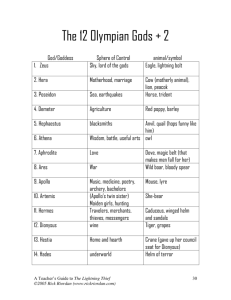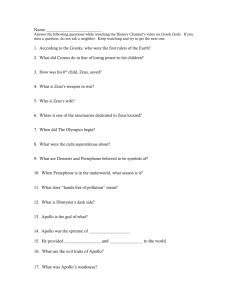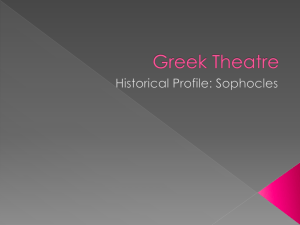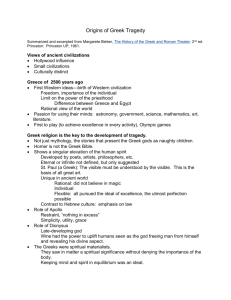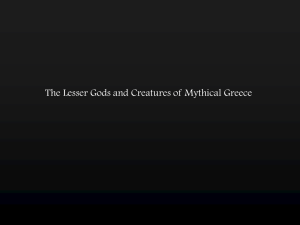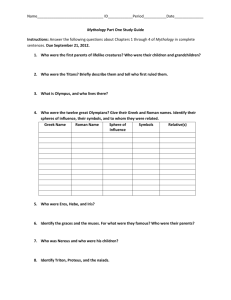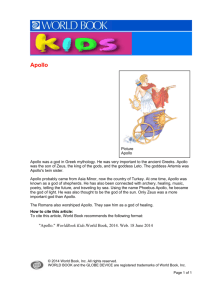File - Anne W. Anderson
advertisement
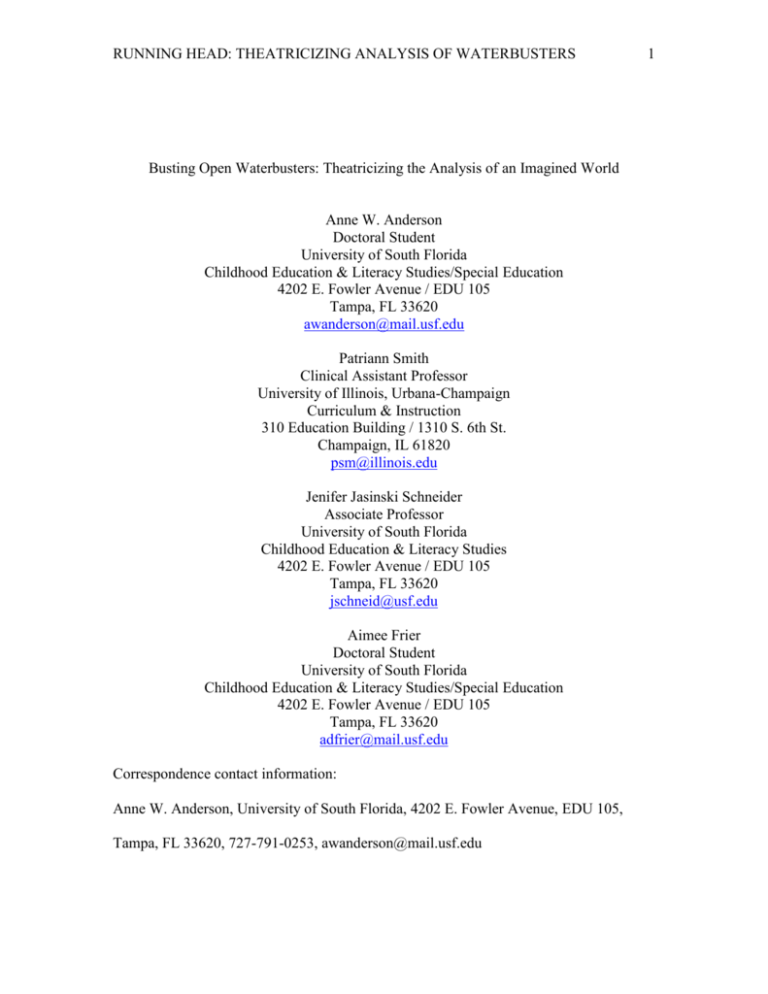
RUNNING HEAD: THEATRICIZING ANALYSIS OF WATERBUSTERS Busting Open Waterbusters: Theatricizing the Analysis of an Imagined World Anne W. Anderson Doctoral Student University of South Florida Childhood Education & Literacy Studies/Special Education 4202 E. Fowler Avenue / EDU 105 Tampa, FL 33620 awanderson@mail.usf.edu Patriann Smith Clinical Assistant Professor University of Illinois, Urbana-Champaign Curriculum & Instruction 310 Education Building / 1310 S. 6th St. Champaign, IL 61820 psm@illinois.edu Jenifer Jasinski Schneider Associate Professor University of South Florida Childhood Education & Literacy Studies 4202 E. Fowler Avenue / EDU 105 Tampa, FL 33620 jschneid@usf.edu Aimee Frier Doctoral Student University of South Florida Childhood Education & Literacy Studies/Special Education 4202 E. Fowler Avenue / EDU 105 Tampa, FL 33620 adfrier@mail.usf.edu Correspondence contact information: Anne W. Anderson, University of South Florida, 4202 E. Fowler Avenue, EDU 105, Tampa, FL 33620, 727-791-0253, awanderson@mail.usf.edu 1 BUSTING OPEN WATERBUSTERS 2 Busting Open Waterbusters: Theatricizing the Analysis of an Imagined World Evaluating students’ digital compositions, which depict imagined worlds constructed from layers of multi-modal texts, raises the philosophical questions, debated through the ages, of what constitutes art, what constitutes meaning, and whether art and meaning are to be found in the process or in the end product. When more than one researcher evaluates the same work, combining both persons’ thoughts and voices into a coherent analysis, the inherent tensions of the debate become more challenging. One way to capture analytic complexity is to embody each voice in a character, place the characters on a stage, and listen to their resultant dialogue. In this paper, we discuss the process of theatricizing our four-tiered analysis of “Waterbusters,” a video produced by 6th grade students. We embody the dichotomy as a dialogue between Apollo and Dionysus, moderated by their father, Zeus. Setting the Stage for Locating Art and Meaning In considering issues of process and product, Athanases (2008) described this divide in terms of the dichotomy between the Greek gods Apollo—“god of theory, of clear and rational understanding” and “linked to the static arts of sculpture and architecture and of distanced introspection and repose”—and Dionysus—“god of dynamic arts such as drama, music, song, and dance; of art as life in process” (p. 119). Callois (1958/2001) termed the divide as one between “ludus: play as a rule-governed system” and “paidea: a looser, more chaotic form of play” (as cited in Burns, 2009, p. 158), considering play in the commonly accepted metaphor that life is a game we can either play by the established rules (evoking the Apollonion or luddite) or ignore them to our peril while pursuing heightened levels of creativity (evoking the Dionysian or paidean). Applying these analogies to the questions of evaluating children’s digital work and of determining whether the work has artistic value—suggesting elements of imaginative thought— THEATRICIZING ANALYSIS OF WATERBUSTERS 3 and/or conveys meaning—suggesting elements of rational thought—raises further questions of who establishes the rules for producing such work, who establishes the standards by which such works are evaluated, and whether it is the final product or the process that ought to be examined. We bring these ethereal, philosophical questions down to earth by applying them to a specific product, a video produced by 6th grade students from a public charter school. The video, “Waterbusters,” was one of several videos produced by teams of students, guided by preservice teachers who were themselves students in a writing/composition methods course taught by one of the authors, a faculty member at a large university (Author 3, in press). Each video focused on a different environmental issue in the College of Education, and all videos were submitted as part of a university-wide grant-writing project on sustainability. The written application included a 65-page report (Author 3, 2011) consisting of an introduction of the project, an overview of the teaching, and detailed explanations of each project. The overall theme was sustainability. Our focus group of students attended to broken sprinklers wasting water and, by extension, money. The material produced from the grant application—both the videos and the written report—provided much data for further analysis. Subsequently, Authors 1 and 2, doctoral students studying multimodal and multimediated literacies under the direction of the same faculty member who had created the video project, sought to discover the meanings implicit in the students’ uses of different modalities and to consider the collective impact of this multimodal, multimedia text. Chandler-Olcott (2008) said “semiotic activity is about selecting which modes (e.g., spatial, visual, audio, gestural, and/or linguistic) need to be emphasized in a particular context to achieve a particular end” (p. 251). More than just selecting modes and then deciding when, where, and how to emphasize one or more modes, the goal of a multimedia project, as Kress and Van Leeuwen (2001) noted, is to combine the modalities to create “an THEATRICIZING ANALYSIS OF WATERBUSTERS 4 entire semiotic product or event” (as cited in Chandler-Olcott, 2008, p. 251). In a sense, the combination of modes to convey a message can be said to be analogous to the fable of the bundle of sticks being stronger than its individual component parts. Scripting the Scene: Analyzing and Theatricizing Author 1 and Author 2 were students in a graduate-level multimedia literacies course taught by Author 3. The year prior to this course, Author 3 taught an undergraduate teaching writing/composition methods course to preservice teachers. These preservice teachers worked with groups of 6th grade students from a public charter school to produce short public-service announcement videos about an environmental issue. These videos became part of a sustainability grant proposal submitted to the university. In the multimedia literacies course, Author 3 directed the graduate students, including Authors 1, 2, and 4, to view the videos (along with another group of student-produced videos that focused on social studies and science content) and to evaluate and analyze them. The instructions for the first four weeks were the same: Borrow concepts and strategies from the readings to analyze some aspect of these texts. You may analyze within one sample or across several. The focus of the analysis and the selection of text(s) is up to you, but…show clear evidence that you have applied or reappropriated concepts and strategies from the readings. Discuss your process and results…. [consider] text, images, movement, sound, camera shots, etc. For each one,.. analyze themes, linguistics, discourse, technical production, etc. (Author 3, 2012) On the fifth week, Author 3 pointed out that “rather than looking solely at images, or movement, or text, the authors [of our readings] examine the interstitial spaces,” (Author 3, 2012). On the last week, Author 3 instructed us to look beyond the readings, to consider the video as part of a larger body of literature, and to contemplate what questions had not been asked or answered. THEATRICIZING ANALYSIS OF WATERBUSTERS 5 How We Applied Rodriguez and Dimitrova’s (2011) Four-Tiered Model Coincidentally, Authors 1 and 2 chose the same video, “Waterbusters.” Each gravitated, separately, to Rodriguez and Dimitrova’s (2011) four-tiered, systematic model of considering the video at different levels, albeit to differing degrees (Tables 1 and 2). At the first level, the denotative level of interpreting visual elements, we described literally what we saw in the product. At the second stylistic level, we noted the choices made by the students and preservice teachers who functioned as videographers, sound editors, costumers, prop managers, actors, and others involved in the process of creating a film. Connotatively, the third level of Rodriguez and Dimitrova’s model, we interpreted symbolically what was presented in each scene. At the fourth level, we discussed the ideological representations conveyed by the product as a whole. We completed this process separately, and our resultant analysis was similar, but different. Combining Voices and Theatricizing the Analysis When Author 3 suggested we consider presenting the analyses at the Literacy Research Association Conference, we were intrigued; but we knew we had different writing styles and voices. Additionally, Author 2 wrote about the entire video, while Author 1 focused more closely on the three opening scenes. We realized standard academic formats minimize philosophical differences of opinion and, to develop a cohesive proposal and paper for LRA, we turned to ethno-theater or performance ethnography as a method for including a multiplicity of voices. Previous ethno-theater or dramatic research has highlighted differences by focusing on participant interviews or field notes (e.g., Anderson, 2007; Bird, 2011; Carter, 2010). In other instances (e.g., Author, 2011; White & Belliveau, 2011), the researchers theatricized and performed the data in front of varying types of audiences. Still, others have used non-public THEATRICIZING ANALYSIS OF WATERBUSTERS 6 dramatic storytelling sessions, constructed performances, fictional characters, and artistic renderings to explore multiple voices (e.g., Greenwood & McCammon, 2007; Gray, 2009). In our own case, we felt our disparate voices lent themselves to dramatized dialogue; and developing a theatricized reading of our analyses would lead to further insight. Recalling Athanases’ (2008) discussion of the Apollonian and the Dionysian approaches to meaning, we wondered if, instead of speaking verbatim in our own voices from our separate analyses, we could assume the characters of Apollo and Dionysus to explore oppositional perspectives about evaluating product versus process, aesthetic meaning versus pragmatic meaning, and childproduced (immature) artifacts versus adult-produced (mature) artifacts. Saldaña (2003) spoke to the concept of dramatizing data but did not address the researchers’ assuming characters other than themselves or anyone else directly involved in the research project. However, Saldaña (2003) discussed the “appropriateness of a story’s medium” (p. 219) and noted that playwrights have been “representing social life on stage” (pp. 230-231) for more than two millennia. Although we were exploring conceptual ideas more than social life—we were not dramatizing the group production of the video nor our own process of viewing the data. In this sense, we proceeded with our experiment of dramatizing our analyses through voices other than our own, but we remained reluctant to term this ethnotheatre. Additionally, because we used costumes and props, theatricizing the analyses seemed a more appropriate description. Scripting, Rehearsing, and Performing Theatricizing the analyses on paper, bringing the script to life, then tailoring the drama to fit the constraints of a presentation at an academic conference involved several iterations. Author 1 used the narrative analyses to write a partial draft using three voices, with one person doubling briefly as a narrator. However, at the first read-through (via video-conference), a fourth person THEATRICIZING ANALYSIS OF WATERBUSTERS 7 (Author 4) was present who read the part of the narrator and who was agreeable to doing so at the conference. Hearing the four voices presented Author 1 with new options for the remainder of the sketch. We also discussed using a playbill to give the audience an overview and a slideshow to present contextual information. We were concerned that conference attendees would not expect a theatrical performance nor would they be familiar with the video on which the analysis and the performance were based. In the second draft of the drama, Author 1 changed the part of the Narrator to function as a Greek Chorus, a typical device found in most classical Greek tragedies, although used with varying effect (Weiner, 1981). With the Chorus acting as a bit of a foil, Author 1 heightened the contrast between Dionysus and Apollo by adding visual and verbal comedic effects. Author 1 also included ideas for slides to be presented at particular points in the sketch, and she began drafting a playbill. At the same time, Author 3 worked to create a slide show presentation, which included background information about the initial video-composing project. In the second video-conference, we realized we were working from slightly different conceptions about what kinds of information the audience needed to make sense of the presentation. For instance, Author 3 felt the audience needed to see the entire three-minute video, while Author 1 felt the first 21 seconds was sufficient as the bulk of the analysis was focused on this segment. We also were scheduled to present last (of three papers), and we were concerned that we might not have a full 20 minutes to present. Saldaña (2003) observed that entertainment is the goal of theatre artists—not education or enlightenment, which is the goal of most researchers—and we were experiencing the tension between those two goals. We needed to be mindful that we had, as Saldaña (2003) put it, a “responsibility to create an entertainingly informative experience for an audience, one that is aesthetically sound, intellectually rich, and THEATRICIZING ANALYSIS OF WATERBUSTERS 8 emotionally evocative” (p. 220). After discussion, we agreed the audience needed more information in order to enter into the aspect of being entertained. Too little knowledge might leave them merely confused or even angry at the thought their time was being wasted. Accordingly, we decided to expand the backstory by giving more information about the initial project, to show the video in full (insert link after review), and to trim the dramatization. Our third rehearsal took place in a hotel room at the conference. During this rehearsal, we donned our costumes (draped scarves to represent togas, artificial laurel wreaths, and a mask for the Chorus) and practiced gestures. We coordinated dialogue with the timing of the slides and discussed how we would use the presentation room space. We planned a fourth rehearsal in the presentation room, but the room was unavailable, so we did a final read-through. We did not try to memorize the dialogue, but we wanted to provide a theatrical reading for the audience. Prior to the session, we distributed playbills to attendees to give them time to read about the characters, cast, and project. To introduce our paper, Author 3 used the slides to describe the project, play the video, and foreground the concept of presenting the analysis through the characters of Apollo, Dionysus, and Zeus. Then, we donned our costumes and began. Live! From Mount Olympus: “Busting Open Waterbusters” Characters: Zeus/Researcher 1: Father of gods and men, god of the sky and of the heavens Apollo/Researcher 2: Zeus’s son by Leto, a Titan; associated with sun and light, Apollo god of music, “prophecy, colonization, medicine, archery (but not for war or hunting), poetry, dance, intellectual inquiry and the carer of herds and flocks” (Apollo, 2004, ¶1). Dionysus/Researcher 3: Zeus’s son by Semele, a mortal; called ‘Bacchus,’ Dionysus is “god of wine, agriculture… patron god of the Greek stage” (Dionysus, 2007, ¶1) THEATRICIZING ANALYSIS OF WATERBUSTERS 9 Chorus: Weiner (1980) discussed the Chorus being woven “into the fabric of the play” until it “resembles a ‘collective character’” (p. 206). Costumes: ZEUS, APOLLO, and DIONYSUS wear laurel wreaths and simple scarves to resemble draped togas. The CHORUS wears a simple mask. Props: Slides are projected throughout. Setting: The lofty heights of Mount Olympus, where the gods dwell between heaven and earth. (As the scene begins, RESEARCHERS 1, 2, and 3 (ZEUS, APOLLO, and DIONYSUS) sit at the conference table. The CHORUS stands and faces the audience. SLIDE: Title Slide shows the playbill logo, title, and researchers’ names / affiliations) CHORUS: (addressing the audience) Hail, mortal audience! Greetings in the name of Zeus, and (gestures to indicate the performance space) welcome to Mount Olympus, where the gods observe and comment on mortal lives. SLIDE: Theory & Theatre reads: Greek word thea means view / Theory and Theatre (Athanases, 2009, p. 119) Today, mortal researchers Author 1 (RESEARCHER 1 / ZEUS stands, dons costume, and looks down at an unseen earthly scene), Author 2 (RESEARCHER 2 / APOLLO stands, faces away from audience on one side of ZEUS, and dons costume), and Author 3 (RESEARCHER 3 / DIONYSUS stands, faces away from audience on the other side of ZEUS, and dons costume) assume the roles of ZEUS and his two sons—half-brothers—APOLLO, “god of theory...linked to the static arts,” and DIONYSUS, called Bacchus by the Romans and considered the “god of dynamic arts [such as theatre]...of art as life in process” (Athanases, 2009, p. 119). (Beat) One day, Zeus, looking down from Mount Olympus, saw a group of 6th grade students creating a video. (APOLLO and DIONYSUS step forward and stand on either side of ZEUS) THEATRICIZING ANALYSIS OF WATERBUSTERS 10 ZEUS. (gestures below; APOLLO and DIONYSUS turn their attention to the scene) My sons, mortal children are staging scenes and creating a video, “Waterbusters” (SLIDE: beginning frame of video) to focus attention on the problem of broken sprinkler heads, at a university campus, wasting water and, by extension, money. What do you suppose this means? APOLLO. (disdainfully) What possible meaning could be contained in something—especially video—made by children? Didn’t one of these mortals, Vygotsky, write that “a lack of technical skill prevents [children’s] creations, no matter how meaningful to their personality development, from reaching artistic status” (as cited in Smagorinsky, 2011, p. 325)? DIONYSUS. Another mortal thinker, Figueiredo (2011), might call them “world builders”— ”creating meaning from fragments of data” (p. 92). What a fluidly artistic process! APOLLO. Static products such as sculpture, architecture, even painting are art—one can ponder and reflect on their meaning. But video produced by children? Let us consider this rationally, O Zeus. First, what do you mean when you ask what this means? Do you refer to the meaning contained in the product of the video itself? DIONYSUS. Or to the meaning derived during the artistic process of creating the video? APOLLO. Meaning only exists in a product. (CHORUS shakes head and makes an “Oh, please—not in front of our guests” sort of gesture during this next exchange) DIONYSUS. Process! APOLLO. Product! DIONYSUS. Process! ZEUS. Silence! This cannot and will not be decided by bickering. At the moment, the question is how to evaluate such works. (Beat) You will view the multimodal text in four iterations using the THEATRICIZING ANALYSIS OF WATERBUSTERS 11 model developed by other mortals, Rodriguez and Dimitrova. (SLIDE: Levels of Visual Framing lists citation for Rodriguez & Dimitrova (2011) and four pairs of words: Denotative / Literal, Stylistic / Techniques, Connotative / Symbolic, Ideological / Critical). CHORUS. (without emotion) Denotative. (Beat) Stylistic. (Beat) Connotative. (Beat) Ideological. (faster) Denotative. Stylistic. Connotative. Ideological. (cheering enthusiastically) Denotative, Stylistic, Connotative, Ideological—Go-o-o-o-o, gods!!! (notices audience, stops, composes self) (SLIDE(S): Theory is on the screen during this next exchange, but is not read. (1) “[M]ultimodal texts require different cognitive strategies from written texts because the meaning in visual images is derived from spatial relations whereas the meaning in written text emanates from its temporal sequence” (Serafini, 2011, p. 343) (2) “Semiotic activity is about selecting which modes (e.g., spatial, visual, audio, gestural, and/or linguistic) need to be emphasized in a particular context to achieve a particular end” (Chandler-Olcott, 2008, p. 251) (3) The goal of a multimedia project is to combine modalities to create “an entire semiotic product or event (Kress and van Leeuwen, 2001, as cited in Chandler-Olcott, 2008, p. 251). (APOLLO and DIONYSUS both open their mouths as if to say something, but ZEUS speaks) Zeus: And we will cast lots to determine who speaks first. (mimes taking a token from each son, shaking them together, closing his eyes, and drawing one) Apollo, you shall speak first. (APOLLO begins to smirk) Dionysus, you shall have the last word. (DIONYSUS smirks) APOLLO and DIONYSUS. Agreed. ZEUS. (ZEUS sits and assumes the role of moderator) Proceed. APOLLO. (Imperiously) Considering visuals as denotative and stylistic-semiotic systems we examine the objects and elements observed in the visual, then consider the organization of THEATRICIZING ANALYSIS OF WATERBUSTERS 12 these into themes (Rodriguez & Dimitrova, 2011, p. 53). We begin, therefore, with the (with a touch of disdain) stage. (Beat) Let it be known that, despite my disdain for their artistic value, I can speak to the “fluid arts” as well as my brother. (DIONYSUS gestures “Oh, brother” and becomes increasingly bored, looks at imaginary watch, etc.) As Honzl (1940/1998) noted, “although a stage is usually a construction, it is not its constructional nature that makes it a stage but the fact that it represents dramatic place” (p. 270). So, for the first actor, the bench (CHORUS gestures as game-show model and indicates bench in SLIDE) on which he sits becomes a stage, while for the second and third, the steps (CHORUS indicates steps) and sidewalk (CHORUS indicates sidewalk) on which they move assume a stage-like quality. (SLIDE includes three images: (1) the student on the bench, (2) the student going down the steps, and (3) the professor on the sidewalk.) DIONYSUS. (overly polite) My brother fails to note the stages he describes are static objects, the sculptures, if you will, of which he so highly speaks and on which mortal creatures play their parts. (Beat) (CHORUS indicates various items as mentioned) The opening scene fades in from a blur to a scene of a person, (becoming more effusive) wearing sneakers, green shorts, a white t-shirt, and a bright green wig!—love it!—sitting outdoors on a bench, head tilted back, and eyes closed. A subtitle proclaims, “One day at the College of Education….” APOLLO. The fact that these individuals represent someone, that they signify a role in a play (shudders) implies that they can also be considered stages in themselves. DIONYSUS. (Ignoring Apollo) Next, we hear a snore and orchestral music (mimes gentle conducting; CHORUS joins in) playing a pastoral theme. This soft music contrasts with two streams of water (mimes shooting; CHORUS joins in; APOLLO looks down his nose) pow, THEATRICIZING ANALYSIS OF WATERBUSTERS 13 pow, pow! directed, from an unseen source, at the student. The student raises his arms in defense but is overpowered and falls off of the bench. (DIONYSUS and CHORUS high five) APOLLO. The sprinklers, while not visible in the film, produce water which functions, as Honzl puts it, as a “stage prop” (Honzl, 1940/1998, p. 274), symbolizing aggression. DIONYSUS. (appealing to ZEUS) I thought we were not discussing connotations here. ZEUS. (speaking to APOLLO) Your brother has a point. APOLLO. My brother “discussed” connotations by his actions and extraneous verbalizations. ZEUS. (speaking to DIONYSUS) Your brother has a point. Proceed. DIONYSUS. Within this first scene, then, we see the modalities of the— CHORUS. Spatial. APOLLO. —outdoors, moving from sitting on a bench to falling off a bench— CHORUS. Visual. DIONYSUS. —colors, costumes/clothing, furniture, streams of water— CHORUS. Audial. APOLLO. —snore, music— CHORUS. Choreographical and gestural. DIONYSUS. —falling, raising arms to defend self— CHORUS. Alphabetic. APOLLO. —subtitles— DIONYSUS. —all of which are stylistic choices made in the process of conveying the idea of a helpless student being assaulted and overpowered by water. APOLLO. To answer the question, “Who or what is depicted here?” is partially to achieve the goal of describing the scene at its most basic level. THEATRICIZING ANALYSIS OF WATERBUSTERS 14 DIONYSUS. The scene fades, and a new scene takes its place, also set outdoors. This time— APOLLO. (cuts DIONYSUS off to forestall more theatrics; DIONYSUS is left with his mouth open) This time a person in sunglasses, a hoodie, shorts, and sneakers, swaggers down a set of steps in time to a synthesized beat reminiscent of rap music. DIONYSUS. A subtitle appears, which reads, “Later that same day…” Again— APOLLO. (as before) Again, two streams of water assault the person. The person backs away. DIONYSUS. The scene changes a third time, we are again outdoors. Now we see— APOLLO. Now we see a person wearing a ball cap and the mask of a middle-aged man. “He” struts to a clarinet playing rag-jazz; and a subtitle appears, “Soon after…” This man, too— DIONYSUS. (cuts APOLLO off and leaves APOLLO with his mouth open) —is assaulted by streams of water (mimes shooting; CHORUS joins in; APOLLO looks down his)—dzdzdzdz! He raises his hands, tries to defend himself, but is overpowered and falls flat on his back. (CHORUS and DIONYSUS high five) APOLLO. (appealing to ZEUS) Really? ZEUS. You must admit he is…entertaining. Proceed. APOLLO. (SLIDE: Still Images / Other Scenes shows still images of the newscasters, protesters, and Waterbusters.; CHORUS again assumes game-show model role) Continuation of the film reveals a makeshift newsroom set with two news reporters, wearing masks, who report events related to the sprinkler mishaps. DIONYSUS. Outraged protesters bang (demonstrates) on closed doors of the maintenance office, demanding the sprinkler problems be solved (strikes a “Let justice be done” pose). APOLLO. (ignoring DIONYSUS) Intermittently, the Waterbusters appear, collectively at times and individually during others, offering solutions. THEATRICIZING ANALYSIS OF WATERBUSTERS 15 DIONYSUS. (behaving himself) Stylistically, the videographers chose medium and full shots to frame the three subjects— APOLLO. —signifying relationships ranging from personal to social (Rodriguez, and Dimitrova, 2011, p. 55). Aurally, the volume remains somewhat constant—there is no appreciable difference between one segment and the next— DIONYSUS. —suggesting the viewer/hearer should give equal weight to each incident. The sleeping student is no more and no less significant than the other two people. ZEUS. As you have introduced connotative meaning into the conversation, speak now to that which you have described in terms of the mortal Eco’s (1994) idea of ostention. CHORUS. (Reads Slide: Ostention: a form of signifying, occurs when a person (or an object) is “picked up [from] among the existing physical bodies, [is] de-realiz[ed]…in order to make it stand for an entire class” (Eco, 1994, p. 281).) Ostention: a form of signifying, occurs when a person (or an object) is “picked up [from] among the existing physical bodies, [is] de-realiz[ed]…in order to make it stand for an entire class” (Eco, 1994, p. 281). DIONYSUS. The first person wears student attire and a green frizzy wig, from a pep rally. APOLLO. By ostention, this person symbolizes “rah-rah, go school” students, ones, perhaps who expend their energies in places other than class and end up sleeping on benches. DIONYSUS. The second person wears a zipped-up sweatshirt with the hood pulled up. “Hoodies,” are worn by people of many races, but they have become particularly identified with African American youth. The hoodie and rap music ostend this person into symbolizing African American students, perhaps even all non-White students. THEATRICIZING ANALYSIS OF WATERBUSTERS 16 APOLLO. The third person wears a ball cap, suggesting someone not quite with the current trend of wig or hoodie. The ball cap, combined with the middle-aged face mask and Dixieland jazz, ostend the one person into all older people on campus. DIONYSUS. Through the visual, aural, and choreographical modalities, then, we see a Typical (if stereotyped) White Student, a Typical (if stereotyped) non-White Student, and a Typical (if caricatured) Professor/Adult, each of whom has been the victim of renegade waters. APOLLO. Clearly, the unverbalized— DIONYSUS. —but not unspoken—message transcending the individual components is, APOLLO, DIONYSUS, and CHORUS. (in unison) “This happened to us; it could happen to anyone; (pointing to audience) it could happen to you.” ZEUS. And ideologically (Slide: Ideologies reads: (1) Who/what is threatened? (2) By whom? (3) Who/what has power to resolve the issue?) APOLLO. In particular contexts (rolls eyes at DIONYSUS and CHORUS), water outbursts could be conceived of as fun. These water outbursts are portrayed, however, as harmful wastage. The Waterbusters represent those who see water outbursts as a threat, thereby creating the social context in which conservation versus wastage becomes the ideological abstraction. DIONYSUS. The Waterbusters appear both collectively and individually, a choice (looks pointedly at APOLLO) suggesting the importance of approaching this problem in a unified manner while emphasizing each individual’s ability to make a difference. APOLLO. Whatever the case, the semiotic phenomena are designed to function similarly to “everyday conversational interaction” (Eco, 1977, p. 286). Viewers may decide to listen, to become waterbusters themselves, to find a way to solve the problem, or to join the protest. THEATRICIZING ANALYSIS OF WATERBUSTERS 17 DIONYSUS. (triumphant) Did you say designed? Then you admit viewers derive cognitive and emotional meaning from the process the children used in deciding what to portray and how! APOLLO. I said viewers MAY decide. While I am forced to applaud the children’s attempts, given the crudity of the product itself, it remains only an attempt at conveying meaning. DIONYSUS. Meaning is in the process. Mortal, Figueiredo (2011), suggested comics creators— APOLLO. Comics creators? Really, Dionysus— DIONYSUS. Hear me out, Brother. Comics creators are information designers (p. 87) (SLIDE: Image of a comic strip: Comics creators work to “create meaning from fragments of data by organizing the selected pieces into an ordered view of the world” (Figueiredo, 2011, p. 92).) who “create meaning from fragments of data by organizing the selected pieces of data into an ordered view of the world” (p. 92) that flow across “segments of frozen scenes [enclosed] by a frame or panel” (Eisner, 1985, as cited in Figueiredo, 2011, p. 92). APOLLO. And? DIONYSUS. If we consider “Waterbusters” as a moving comic strip—each scene fluid, rather than frozen, but still enclosed by transitions from scene to scene that fragments data—and if we consider the creators of “Waterbusters” as artistic information designers—world builders, APOLLO. Go on. DIONYSUS. …our task is to consider the designing or artistic process involved in their making the world over in the image of the creators, in this case, the students’ own selves (p. 88). APOLLO. (repeating slowly) “The world made over in the image of the crea--” You mean like gods? We’re supposed to think of these children as gods capable of creating worlds? (CHORUS whispers in APOLLO’s ear) APOLLO. Say! You’re right! (High fives CHORUS) Then you admit it is a product, a created THEATRICIZING ANALYSIS OF WATERBUSTERS 18 world that is of ultimate importance? ZEUS. (stands and interjects with laughter) It appears you both have been had. In arguing for a product, Apollo, you have dissected and evaluated the artistic process. And you, Dionysus, in arguing for the process, have ended up with a product on which your evaluations rest. I declare this debate a draw. Shake hands (APOLLO and DIONYSUS obey) and let us close the veil over this scene. (ZEUS waves his hand over the earthly scene and turns to leave) APOLLO. (gathering his papers) Perhaps when these children have matured, they will produce something worthy of future discussion. DIONYSUS. (gathering his papers) It would appear what “these children” produced in their present immaturity was worth our present discussion. (APOLLO and DIONYSUS confront each other; the CHORUS cringes and covers her ears) APOLLO. Future. DIONYSUS. Present. APOLLO. Future! DIONYSUS. Present! Zeus: (stepping between APOLLO and DIONYSUS) Silence! (ZEUS, APOLLO, DIONYSUS, and CHORUS freeze for a two-count beat, then bow to audience) Performance Post-Mortem: What We Discovered from Theatricizing the Analysis Each of us approached this project with different levels of experience with drama. Author 1 wrote, directed, and staged many short non-academic dramatic programs with amateur actors of all ages and reading abilities; additionally, she completed script-writing courses and created another script based on research. Author 3 studied and taught process drama techniques and wrote and acted in a research-based ethnodrama. Authors 2 and 4 both are experienced THEATRICIZING ANALYSIS OF WATERBUSTERS 19 instructors and presenters, but Author 4, in particular, admitted to “SEVERE drama anxiety” and said “the prospect of performing was a bit intimidating” (Authors, 2013). Despite our disparate theatrical backgrounds, we each made similar discoveries about the use of space and time, about the processes of composing and evaluating, and about the concepts of teaching and learning. The Use of Space and Time While technology allowed us to share thoughts and rehearse the script across time zones, we were struck by the differences when we physically were in the same room for the third rehearsal. The presence of beds and luggage limited our movements, yet each of us felt more connected to the others and to the ideas of the script. As Author 3 put it, “It helped with body arrangement, tone, and timing.” Author 4 noted the physical proximity relieved some of her anxiety about the performance and said, “Being in the same physical space allowed us to see gesture, gauge the physical spaces we needed for our roles, and bring it all together with costumes.” Nor was it just a matter of blocking movements; Author 3 said walking (as opposed to merely talking) through the script improved her understanding of the concepts. Nevertheless, because we were not able to rehearse in the presentation room, we could only gauge the physical spaces needed. When we actually performed in the session, each of us felt physically awkward as the projector and screen pushed our presentation space to the sides of the room. Additionally, Author 3 had trouble putting her costume on while controlling the slide presentation and felt she did not go “into full acting” as she would have with more rehearsal; Author 4, whose part included some comic moments, felt she “would have liked to execute my part with more ‘umph’ and could have done so with more practice in the actual space; Author 1 felt she and Author 2 were not arranged as effectively as they could have been to highlight the disagreement between the two perspectives. Again, however, despite Author 4’s feeling she THEATRICIZING ANALYSIS OF WATERBUSTERS 20 could have delivered her part with more energy, Author 3 specifically commented that she had “never really understood Author 4’s denotative/connotative chant until she turned to the screen and read it over and over again. That was brilliant!” We each recognized our rehearsal time was very limited. Author 1, perhaps because of her more extensive experience with scripted drama, felt we had missed an opportunity to connect more deeply with the data and the analysis, an opportunity that comes only with repeated “playing” with lines, inflection, gestures, and blocking. This led us to wonder how the processes of theatricizing academic data/analysis differs from other forms of theater. Or, perhaps, all theater analyzes life-data and academic writing imposes artificial constructs on the gathered data. The Processes of Composing and Evaluating If we consider Rosenblatt’s (1994/1978) idea of poem as constructing/composing meaning based on the reading of a text, then we as readers and actors were composing as much as the author of the script and as much as the students who created the original video. As already noted, Author 1 felt limited rehearsal time diminished the potential of the script—our composition was still in draft form, as it were—but we wondered if there was something deeper we had missed as well. Perhaps theatricizing the data involves a realigning of relationships between people and between researcher(s) and the data. In writing the script, Author 1 was still very much in charge of shaping the analysis. In playing with characters, voices, and lines, we would have allowed the analysis more power to shape us and our thinking. However, Author 2, as Apollo, felt even the limited time we spent caused her to delve more deeply into the concepts and to engage more actively with the theorists we referenced: I assumed an active role in “speaking to” the mortals who helped me make the case for or against the arguments surrounding the data presentation. But I also took on the THEATRICIZING ANALYSIS OF WATERBUSTERS 21 perspective of the [student] actors/actresses who produced the film —I spoke their words and emulated their actions to convey their meanings, I embodied who they presented themselves to be at different points in their performance. In other words, I developed multiple personas in my theatricization that demanded my “entering into” the data and submersing . . . myself into it. Author 4 also noted theatricizing the analysis “presented the theory alongside the data/analysis. … Combining them this way provided . . . a space to consider the audiences.” Audience reaction provides an immediate form of evaluation to any presentation, but how did our theatricizing position the audience—how does this method affect a reader’s or viewer’s receptive willingness and comprehension? Author 4, who observed the audience most, felt everyone was involved, whether or not they “‘got’ everything we were trying to say.” Author 3 received positive comments about the playbill before the session and additional positive comments after the session. Author 2 noted that performing the analysis subjected her work to as much critique as the children received: “I sensed a need to entertain them. If they laughed or watched on eagerly in anticipation of an interesting scene and I failed to fulfill their needs, I felt that my performance of the script was not effective.” Additionally, she connected with the children as composers: “I believed that I gained a greater sense of satisfaction in the rehearsal procedures than in the actual performance, the reasons underlying this I cannot say. I felt more in tune with the script in the absence of the final audience.” Again, we were left with questions. How does an audience mediate performance and performance as product? We discovered that the process of theatricizing the analysis—of producing a performed product—helped us to understand more clearly the role of the children as learners and to appreciate their products as meaningful in and of themselves. We learned, or re-learned, that we, THEATRICIZING ANALYSIS OF WATERBUSTERS 22 as adult readers, glean some information from reading a passage, gain more information from talking about it, but grasp even more from acting it out. The philosophical questions of what constitutes art, what constitutes meaning, and whether art and meaning are to be found in the process or in the end product, are not resolved. In fact, through embodiment and role play, the inherent tensions became even more complicated. References Author (2011) Author (2012) Author et al. (2012) Author et al. (in press) Anderson, M. (2007). Making theatre from data: Lessons for performance ethnography from verbatim theatre. NJ: Drama Australia Journal, 31(1), 79-91. Apollo. (2004). Encyclopedia Mythica. Retrieved November 18, 2013, from Encyclopedia Mythica Online. <http://www.pantheon.org/articles/a/apollo.html> Athanases, S. Z. (2008). Theatre and theory partnered through ethnographic study. In J. Flood, S. B. Heath, & D. Lapp (Eds.), Handbook of research on teaching literacy through the visual and communicative arts, Volume II(119-128). Baines, L. (2008). Film, literature, and language. In J. Flood, S. B. Heath & D. Lapp (Eds.), Handbook of literacy research: Visual, communicative and performative arts (Vol. 1) (pp. 545-557). Mahwah, NJ: Lawrence Erlbaum Associates. Bannerman, H. L. (2010). Movement and meaning: An enquiry into the signifying properties of Martha Graham’s Diversion of Angels (1948) and Merce Cunningham’s Points in Space (1986). Research in Dance Education, 11(1), 19-33. THEATRICIZING ANALYSIS OF WATERBUSTERS 23 Bird, J. (2011). Performance-based data analysis: A dynamic dialogue between ethnography and performance-making processes. NJ: Drama Australia Journal, 34, 35-45. Burn, A. (2009). The case of rebellion: Researching multimodal texts. In J. Coiro, M. Knobel, C. Lankshear, & D. Leu (Eds.), Handbook of research on new literacies (pp. 151-178). New York, NY: Routledge. Carter, M. R. (2010). The teacher monologues: An a/r/tographical exploration. Creative Approaches to Research, 3(1), 42-66. Chandler-Olcott, K. (2008). Anime and manga fandom: Young people’s multiliteracies made visible. In J. Flood, S. B. Heath, & D. Lapp (Eds.), Handbook of research on teaching literacy through the communicative and visual arts (Volume II) (pp 247-257). New York, NY: Lawrence Erlbaum Associates. Dionysus. (2007). Encyclopedia mythica. Retrieved November 18, 2013, from. <http://www.pantheon.org/articles/d/dionysus.html> Eco, U. (2003). Semiotics of theatrical performance (1977). In G. W. Brandt (Ed.) Modern theories of drama: A selection of writings on drama and theatre, 1840-1990 (pp. 279287). Oxford University Press: Oxford, England. Figueiredo, S. (2011). Building worlds for an interactive experience: Selecting, organizing, and showing worlds of information through comics. Journal of Visual Literacy, 30(1), 86100. Gouzouasis, P. (2005). Fluency in general music and arts technologies: Is the future of music a garage band mentality? Action, Criticism & Theory for Music Education, 4(2), 2-18. Gray, J. (2009). Theatrical reflections of health: Physically impacting health-based research. Applied Theatre Researcher/IDEA Journal, 10, Special Section 1-10. THEATRICIZING ANALYSIS OF WATERBUSTERS 24 Greenwood, J., & McCammon, L. A. (2007). The bridge, the trolls and a number of crossings: A foray into the ‘third space.’ NJ: Drama Australia Journal, 31(1), 55-68. Holle, K. A., & Colyar, J. (2009). Rethinking texts: Narrative and the construction of qualitative research. Educational Researcher, 38(9), 680-686. Honzl, J. (1998). Dynamics of the sign in the theater (1940). In G. Brandt (Ed.) Modern theories of drama: A selection of writings on drama and theatre, 1840-1990 (pp. 269-278). Oxford University Press: Oxford, England. (Original work published 1940) Hung, K. (2001). Framing meaning perceptions with music: The case of teaser ads. Journal of Advertising, 30(3), 39-49. Kist, W. (2008). Film and video in the classroom: Back to the future. In J. Flood, S. B. Heath & D. Lapp (Eds.), Handbook of Literacy Research: Visual, Communicative and Performative Arts (Vol. 2) (pp. 521-528). Mahwah, NJ: Lawrence Erlbaum Associates. Mendelson, A. L. (2008). The construction of photographic meaning. In J. Flood, S. B. Heath & D. Lapp (Eds.), Handbook of Literacy Research: Visual, Communicative and Performative Arts (pp. 27-36). Mahwah, NJ: Lawrence Erlbaum Associates. Rodriguez, L., & Dimitrova, D. (2011). The levels of visual framing. Journal of Visual Literacy, 30(1), 48-65. Rosenblatt, L. (1994). The reader, the text, the poem: The transactional theory of the literary work, 2nd ed. Carbondale, IL: Southern Illinois University Press. (Original work published in 1978) Saldaña, J. (2003). Dramatizing data: A primer. Qualitative Inquiry, 9(2), 218-236. Serafini, F. (2011). Expanding perspectives for comprehending visual images in multimodal texts. Journal of Adolescent & Adult Literacy 54(5), 342-350. doi:10.1598/JAAL.54.5.4 THEATRICIZING ANALYSIS OF WATERBUSTERS 25 Smagorinsky, P. (2011). Vygotsky’s stage theory: The psychology of art and the actor under the direction of Perezhivanie. Mind, Culture and Activity, 18(4), 319-341. Weiner, A. (1980). The function of the tragic Greek chorus. Theatre Journal, 32(2), 205-212. http://www.jstor.org/stable/3207113 White, V., & Belliveau, G. (2011). Multiple perspectives, loyalties, and identities: Exploring intrapersonal spaces through research-based theatre. International Journal of Qualitative Studies in Education, 24(2), 227-238. DOI: 10.1080/09518398.2010.495736 Zeus. (2005). Encyclopedia Mythica. Retrieved November 18, 2013, from Encyclopedia Mythica Online. <http://www.pantheon.org/articles/z/zeus.html>
